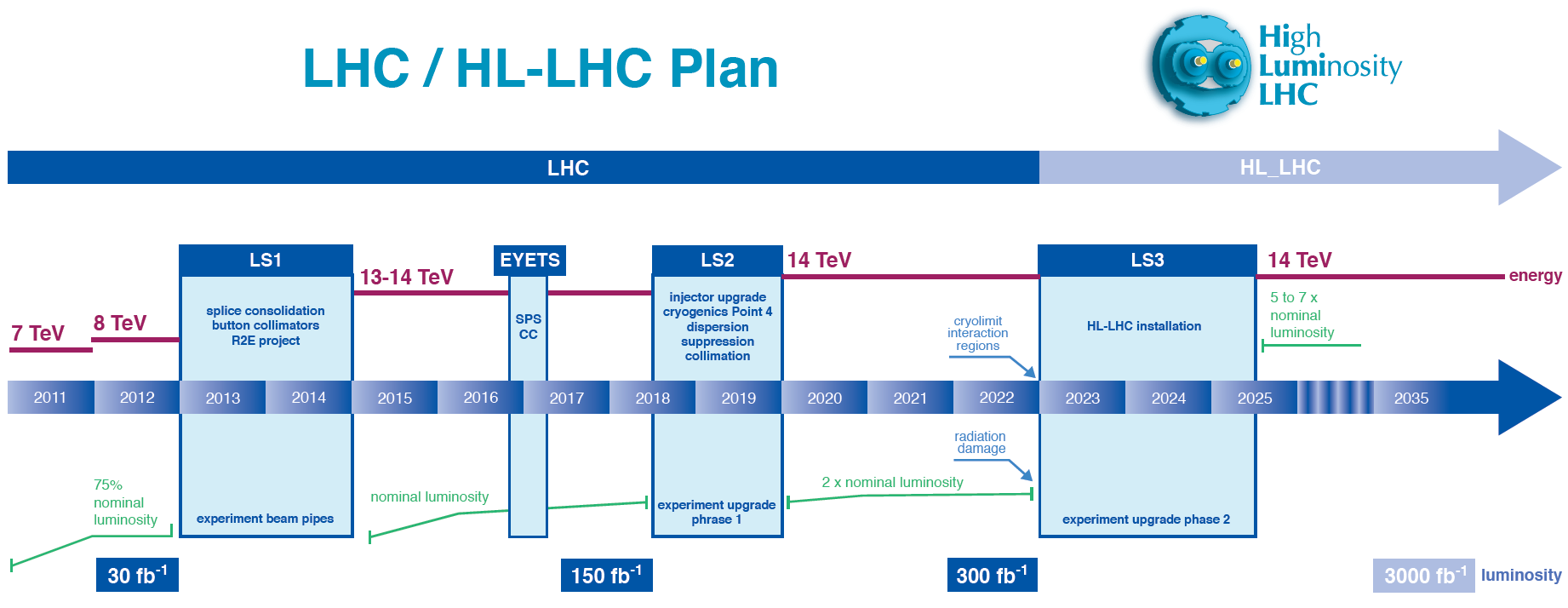![]() Key highlights towards the High Luminosity LHC era
Key highlights towards the High Luminosity LHC era
by Agnes Szeberenyi (CERN)

LHC/ HL-LHC Plan (last update 24.09.2014)
Image credit: HiLumi
More than 110 experts from all over the world gathered in Tsukuba, Japan for the 4th Joint HiLumi LHC/ LARP Annual Meeting between 17 and 21 November 2014, hosted by the High Energy Accelerator Research Organization (KEK).
The event started off with the plenary sessions where management of the collaboration (Dr. Frederick Bordry for CERN, Prof. Yasuhiro Okada for KEK, Dr. Steve Gourlay for USA) gave invited talks. The first plenary session closed with the High Luminosity LHC status updated by Prof Lucio Rossi, HL-LHC Project Leader. Prof Rossi also officially announced the new HL LHC timeline to the collaborators.
One of the highlights of the plenaries was the status update on the Preliminary Design Report, by Dr. Isabel Bejar, as the main deliverable of the project, which will be published soon as a CERN Yellow Report. 3 days focused on the work package parallel sessions, reviewing the progress in design and R&D not only for the EU funded but also non-EU funded work packages.
Key highlights from the Accelerator Physics and Performance activity (WP2) included a refined optics and layout of the high luminosity insertions, an updated impedance model of the LHC and Hl-LHC, and the need of low impedance collimators was confirmed. One of the main results of the IR Magnets activity (WP3) in the past 18 months was a baseline for the layout of the new interaction region. Engineering design and prototyping of most of the magnets has been started, and first tests of near-to-final equipment are expected next year. The Crab Cavities activity (WP4) in this period delivered and tested all 3 prototype crab cavities (4-rod, RFD and DQW) out of which the international design review carried out in in May in BNL made the downselection to proceed with design of the RFD and DQW. A key milestone, to freeze the cavity designs and interfaces, was also met. Highlights from the wrap up talk of the IR Collimation activity (WP5) include the first lay-out for the IR collimation as well as a solid baselines for the collimation upgrade in the dispersion suppressors of around IR7 and IR2. In addition, simulations have continued for advanced collimation layouts in the matching sections of IR1 and IR5, improving significantly the cleaning of physics debris products downstream around the high-luminosity experiments. The Cold Powering activity (WP6) highlights included the world record current of 20kA at 24K in an electrical transmission line consisting of two 20-metre long MgB2 superconducting cables. Other achievements were a conceptual study and preliminary design of a novel concept of cold powering system (cryostat and current leads) connected to the Superconducting Link, definition of cryogenic requirements and flow schemes. The meeting covered also many progress in the other (non-FP7) WPs, especially for machine protection, cryogenics, vacuum, beam instrumentation, etc. A delicate arbitration among the needs of CC test in SPS-LSS4 (Coldex experiment) and the needs of continuing study and tests for e-cloud mitigation by vacuum people was carried out.
The final FP7 HiLumi LHC / LARP Collaboration Meeting will be held between 26-30 October 2015 at CERN. As a contribution to the UNESCO International Year of Light, special events celebrating this occasion will be organized by HL LHC throughout the year. Stay tuned for the latest updates in the CERN Bulletin and CERN website.
